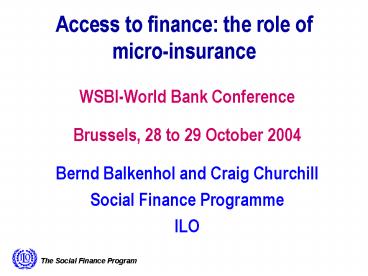Access to finance: the role of microinsurance - PowerPoint PPT Presentation
1 / 18
Title:
Access to finance: the role of microinsurance
Description:
Bernd Balkenhol and Craig Churchill. Social Finance Programme. ILO. The Social Finance Program ... Insurance? ... between insurance and microinsurance? ... – PowerPoint PPT presentation
Number of Views:52
Avg rating:3.0/5.0
Title: Access to finance: the role of microinsurance
1
Access to finance the role of micro-insurance
- WSBI-World Bank Conference
- Brussels, 28 to 29 October 2004
- Bernd Balkenhol and Craig Churchill
- Social Finance Programme
- ILO
2
Access matters
- Gives people the ability to expand options
- Allows consumption smoothing
- Protects people against external shocks
- The right to have access?
3
Barriers to access
- Infrastructure
- Subsistence economy
- Low population density
- Illiteracy
- Poverty
- Gender
- Financial repression
- Inefficient suppliers
- Collateral
4
Access to what sort of finance?
- To manage a micro-enterprise?
- Or
- To manage risk?
- Or
- To do both?
5
When is what financial service appropriate?
- Magnitude of the possible loss?
- Scope for risk spreading?
- Probability of risk occurring
6
Degree of Uncertainty (if, when, how often)
Highly Uncertain
Certain
Flexible Savings and Credit
Life Cycle Events
Small
Property
Health
Death
Insurance
Relative Loss / Cost
Disability
Mass, Co-variant
Flexible Savings / Partial protection
Very Large
7
Insurance???
- risk pooling mechanism combines the resources of
the many to compensate for the losses of the few - premiums for the average loss suffered by the
group rather than the actual cost incurred - risk pooling benefits the few who suffered the
loss, while the many basically receive peace of
mind in exchange for their premium payments
8
What are the differences between insurance and
microinsurance?
- Relevant to the risks of the low-income market
- Affordable premiums in small amounts
- Small benefit amounts
- Simple rules, minimum exclusions and conditions
- Fast payment of benefits
- Strategies to overcome the wariness of customers
(e.g., client education, minimise claim
rejections) - Build on existing informal coping mechanism and
social capital - Different attitude help people to manage risks
9
Contingencies
- Credit life insurance
- Life insurance
- Health insurance
- Fire and other property related insurance
10
Why makes micro-insurance special in the context
of access?
- Opens up access to other financial services
(credit life) - Corresponds to financial needs of all working
poor in the informal economy, entrepreneurs or
not - Substitute for social protection
11
Determinants of demand
- Education and information
- Incidence of risk
- Incidence of fraud in the past
- Socio-cultural taboos
- Income levels and the affordability of premiums
12
Supply determinantstransaction costs
- Selling policies
- collecting premiums
- preventing premium lapses
- verifying claims
- making payouts
13
Controlling TC by linking insuranceto credit
Example AIG in East Africa
- Pays 800 for the accidental death
- of the borrower
- Pays 400 for the accidental death of spouse
- Pays 200 for the accidental death
- of dependents
- Premium 0.5 of loan amount
- Term 4 months
14
Controlling TC by twinning savings to insurance
COLUMNA in Guatemala
- Pays clients family 1-2 times the balance in
their savings account at the time of death - Size of benefit varies based on clients age
- Premiums paid by reducing the interest rate on
savings - COLUMNA, a cooperative insurer manages product
manufacturing, local cooperatives handle
distribution - Advantages simple to manage, low transaction
costs, stimulates savings
15
Facilitating access some models
- Partnership model MFI as agent of commercial
insurance company - partnership with a local utility company
- life insurance through affiliated grocery stores
16
Contextual factors affecting access entry points
- Regulation
- - Minimum capital requirements
- - Documentation requirements
- Re-insurance
- - Broadens the risk pool and enables insurers
to withstand catastrophic losses caused by
covariant shocks - - Allows technical assistance to MI
17
Current ILO research
- Adverse selection, moral hazard, fraud and
over-usage - Appropriate regulation
- Understanding insurance vs. savings
- Re-insurance options
- Reducing transactions costs
18
Thank you
- Social Finance Programme
- ILO
- www.ilo.org/socialfinance































